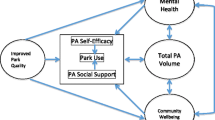Abstract
It is assumed that higher quality recreation facilities promote physical activity and serve communities better. We tested this assumption by comparing changes in the use of an expanded and renovated skate park (a facility for skateboarding) and a modernized senior citizen's center to two similar facilities that were not refurbished. The skate park was nearly tripled in size, and the senior center was remodeled and received new exercise equipment, a courtyard garden, and modern architectural features. We assessed use of these facilities through direct observation and surveyed both facility users and residents living within 2 miles of each facility. We found that making improvements to facilities alone will not always guarantee increased use. Although there was a 510% increase in use of the expanded skate park compared to a 77% increase in the comparison skate park, the senior center had substantially fewer users and provided fewer hours of exercise classes and other programmed activities after the facility was renovated. The implication of our study is that use results from a complex equation that includes not only higher quality recreation facilities but also progamming, staffing, fees, hours of operation, marketing, outreach, and perhaps a host of other human factors.



Similar content being viewed by others
References
Kahn EB, Ramsey LT, Brownson RC, Heath GW, Howze EH, Powell KE, et al. The effectiveness of interventions to increase physical activity. A systematic review. Am J Prev Med. 2002; 22 (4(Suppl.)):73–107.
Frank L, Kerr J, Chapman J, Sallis JF . Urban form relationships with walk trip frequency and distance among youth. Am J Health Promot Active Living Res. 2007; 21 (4(Suppl.)):305–311.
Frank LD, Schmid TL, Sallis JF, Chapman J, Saelens BE . Linking objectively measured physical activity with objectively measured urban form: findings from SMARTRAQ. Am J Prev Med. 2005; 28 (2(Suppl. 2)):117–125.
Roemmich JN, Epstein LH, Raja S, Yin L, Robinson J, Winiewicz D . Association of access to parks and recreational facilities with the physical activity of young children. Prev Med. 2006; 43 (6):437–441.
Giles-Corti B, Broomhall MH, Knuiman M, Collins C, Douglas K, Ng K, et al. Increasing walking: how important is distance to, attractiveness, and size of public open space? Am J Prev Med. 2005; 28 (2(Suppl. 2)):169–176.
Giles-Corti B, Donovan RJ . Relative influences of individual, social environmental, and physical environmental correlates of walking. Am J Public Health. 2003; 93 (9):1583–1589.
Li F, Fisher KJ, Brownson RC, Bosworth M . Multilevel modelling of built environment characteristics related to neighbourhood walking activity in older adults. J Epidemiol Commun Health. 2005; 59 (7):558–564.
Moody JS, Prochaska JJ, Sallis JF, McKenzie TL, Brown M, Conway TL . Viability of parks and recreation centers as sites for youth physical activity promotion. Health Promot Pract. 2004; 5 (4):438–443.
Gordon-Larsen P, Nelson MC, Page P, Popkin BM . Inequality in the built environment underlies key health disparities in physical activity and obesity. Pediatrics. 2006; 117 (2):417–424.
Diez Roux AV, Evenson KR, McGinn AP, Brown DG, Moore L, Brines S, et al. Availability of recreational resources and physical activity in adults. Am J Public Health. 2007; 97 (3):493–499.
Norman GJ, Nutter SK, Ryan S, Sallis JF, Calfas KJ, Patrick K . Community design and access to recreational facilities as correlates of adolescent physical activity and body mass index. J Phys Activity Health. 2006; 3 (Suppl. 1):S118–S128.
Addy CL, Wilson DK, Kirtland KA, Ainsworth BE, Sharpe P, Kimsey D . Associations of perceived social and physical environmental supports with physical activity and walking behavior. Am J Public Health. 2004; 94 (3):440–443.
Plotnikoff RC, Mayhew A, Birkett N, Loucaides CA, Fodor G . Age, gender, and urban–rural differences in the correlates of physical activity. Prev Med. 2004; 39 (6):1115–1125.
McKenzie TL, Cohen DA, Sehgal A, Williamson S, Golinelli D . System for Observing Parks and Recreation in Communities (SOPARC): reliability and feasibility measures. J Phys Activity Health. 2006; 3 (Suppl. 1):S208–S222.
McKenzie TL, Sallis JF, Nader PR . SOFIT: system for observing fitness instruction time. J Teach Phys Educ. 1991; 11:195–205.
Rowe PJ, Schuldheisz JM, van der Mars H . Measuring physical activity in physical education: validation of the SOFIT direct observation instrument for use with first to eighth grade students. Pediat Exerc Sci. 1997; 9 (2):136–149.
ESRI. ArcGIS Desktop Version 9.3. Environmental Systems Research Institute (ESRI); 2007. CA: Redlands.
Jacobs J . The uses of neighborhood parks. In: The Death and Life of Great American Cities. 1993 Modern Library Edition (Chapter 5) New York: Modern Library; 1961, p. 116–145.
Molnar BE, Gortmaker SL, Bull FC, Buka SL . Unsafe to play? Neighborhood disorder and lack of safety predict reduced physical activity among urban children and adolescents. Am J Health Promot. 2004; 18 (5):378–386.
Babey SH, Brown ER, Hastert TA . Access to safe parks helps increase physical activity among teenagers. Policy Brief. UCLA Center for Health Policy Research; December 2005 (PB2005-10): 1-6; 2005.
Weir LA, Etelson D, Brand DA . Parents’ perceptions of neighborhood safety and children's physical activity. Prev Med. 2006; 43 (3):212–217.
Weinstein A, Feigley P, Pullen P, Mann L, Redman L . Neighborhood safety and the prevalence of physical inactivity – selected states, 1996. MMWR Morb Mortal Wkly Rep. 1999; 48 (7):143–146.
Kaczynski A . A more tenable marketing for leisure services and studies. Leisure Sci. 2008; 30 (3):253–272.
Acknowledgements
This paper was supported by the National Institute of Environmental Health Sciences (NIEHS) Grant # P50ES012383-05. We wish to acknowledge the contributions of the promotoras from the Multi-Cultural Area Health Education Center (MAHEC) and AltaMed for their assistance in data collection and survey development.
Author information
Authors and Affiliations
Corresponding author
Rights and permissions
About this article
Cite this article
Cohen, D., Sehgal, A., Williamson, S. et al. New Recreational Facilities for the Young and the Old in Los Angeles: Policy and Programming Implications. J Public Health Pol 30 (Suppl 1), S248–S263 (2009). https://doi.org/10.1057/jphp.2008.45
Published:
Issue Date:
DOI: https://doi.org/10.1057/jphp.2008.45




